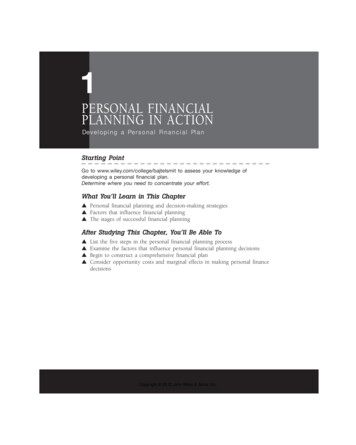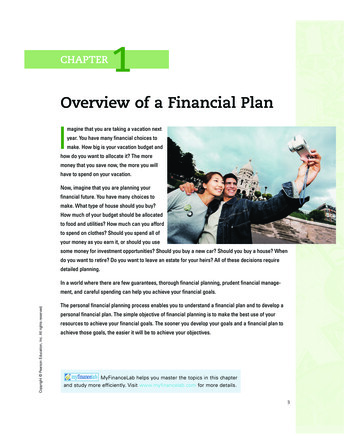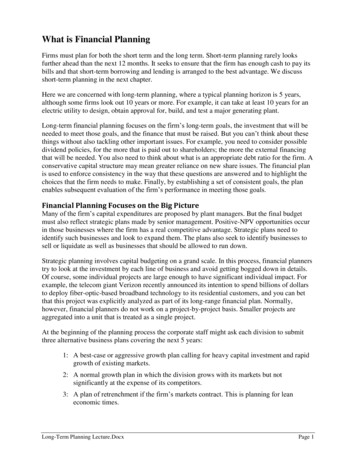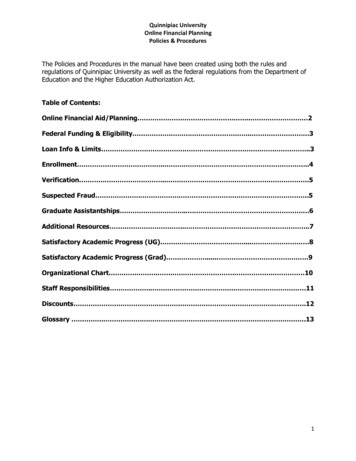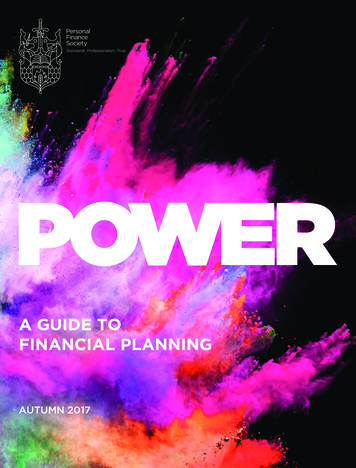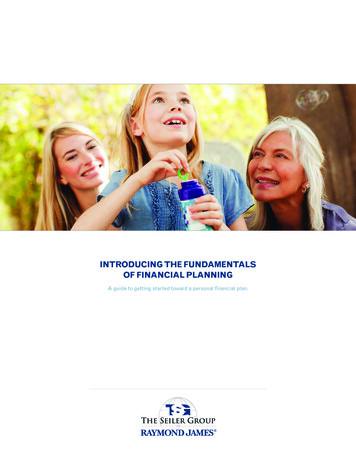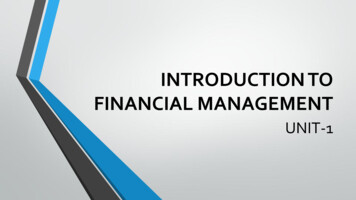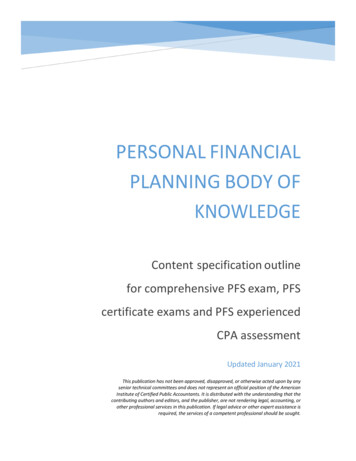
Transcription
PERSONAL FINANCIALPLANNING BODY OFKNOWLEDGEContent specification outlinefor comprehensive PFS exam, PFScertificate exams and PFS experiencedCPA assessmentUpdated January 2021This publication has not been approved, disapproved, or otherwise acted upon by anysenior technical committees and does not represent an official position of the AmericanInstitute of Certified Public Accountants. It is distributed with the understanding that thecontributing authors and editors, and the publisher, are not rendering legal, accounting, orother professional services in this publication. If legal advice or other expert assistance isrequired, the services of a competent professional should be sought.
Table of contentsTable of contents . 2Introduction . 3Income tax planning and integration of topics within the PFP body of knowledge . 3Three ways to earn the CPA/PFS credential . 5Strategies for success on the exams . 8High-level body of knowledge outline. 101. Personal financial planning process . 122. Professional responsibilities and the legislative and regulatory environment . 163. Foundational financial planning concepts. 194. Estate planning . 235. Charitable planning . 306. Risk management planning . 337. Employee and business owner planning . 468. Investment planning . 539. Retirement and Financial Independence Planning . 6310. Elder, special needs, and chronic illness planning . 7011. Education planning . 7412. Special situations . 077 (M-F 9am – 6pm ET)pfs@aicpa.org
IntroductionThe Personal Financial Planning Body of Knowledge (BOK) is an outline of the technical knowledge that aCPA financial planner should be expected to know to competently practice in personal financial planning. ThisBOK outline serves two purposes:1) For CPAs practicing or desiring to practice in personal financial planning: It provides a roadmapfor the various technical competencies that can guide professional development. Not all CPAs plannerswill be experts in all areas, but the BOK outlines the areas in which a fundamental level of knowledge isneeded and emphasizes the interconnectedness of tax planning amongst all other areas of personalfinancial planning.2) For CPAs preparing for exams and assessments: It provides a guide for exam takers to ensure theyare studying appropriate topics for the PFS comprehensive exam, individual PFP certificate exams andthe PFS experienced CPA assessment. The comprehensive PFS exam and experienced CPA assessmentallocates a percentage of the total exam to each subject area so that exam takers have clear expectations.Exam takers can have confidence that this will accurately guide learning and test review as the BOK isused by: authors of the AICPA’s education courses to thoroughly cover all PFP topics in the education andcertificate programs, and authors of the AICPA’s exam review materials to structure a systematic review for the exams, and exam question writers to craft questions on the entire spectrum of PFP knowledge for thecomprehensive PFS exam, the individual PFP certificate exams and the PFS experienced CPAassessment.Income tax planning and integration of topics within the PFP body ofknowledgeIndividual income tax planning is an integral part of personal financial planning. In the past, the PersonalFinancial Planning (PFP) Body of Knowledge included tax as a separate major topic. This approach did notadequately demonstrate the integration of income tax planning within the individual topics throughout the PFPBody of Knowledge. In response to this, the current PFP Body of Knowledge now addresses individual incometax planning in the following manner: Each major section includes one or more sub-topics labeled “Taxation and Income Tax Planning”which highlights the key tax planning considerations at relevant points in that section.Foundational Financial Planning Concepts (section #3) includes the sub-topic “General Income TaxPlanning and Liability Management” covering general tax planning topics not specifically related toa specific area within personal financial planning.To further emphasize the integrated nature of personal financial planning, each major topic within the PFP Bodyof Knowledge (BOK) has been updated with a sub-topic labeled “Integration with Other Areas of Personal
Financial Planning”. This section identifies ways in which this topic impacts other major topics in the BOK.This underscores the importance of considering the impact that changes in one area can have in other parts of aclient’s financial plan and the responsibility to make decisions that are in the client’s best interest.
Three ways to earn the CPA/PFS credentialThe standard pathway 3,000 hours of PFP-related experience over the last five years (up to 1,000 hours of this can be taxcompliance) 75 hours of PFP-related education required (can utilize education from certificate program) over thelast five years Comprehensive 5-hour PFS exam at testing centers nationwideThe certificate pathway 3,000 hours of PFP-related experience within the last five years (up to 1,000 hours of this can be taxcompliance) Earn each of the 5 PFP certificates (more details described below)Each has 14-20 hours of online CPE (modules are 2-4 hours each)Complete 4, 100-minute web-proctored exams within each course on your own computer Passing the 5 certificates (with the education) will meet both the education and exam requirementsof the CPA/PFS credential within a five-year period.The experienced pathway 7,500 hours of PFP-related experience within the last seven years (up to 2,000 hours of this can be taxcompliance) 105 hours of PFP-related education within the last seven years is required of which 13 hours needs tobe earned from the PFS Experienced CPA Education course. Pass the PFS experienced CPA assessment which is a 100-minute web-proctored exam.Which pathway should I take?The standard pathway allows you to take the entire exam in one sitting, completing the credential requirementssooner and with less expense.The certificate pathway allows you to study for and take shorter exams, one at a time, making it moreconvenient and flexible, but taking a longer period of time, with a greater overall cost.The experienced pathway takes into consideration the additional years of experience and allows you to take theassessment in one sitting, making it the most cost-effective approach for experienced practitioners.
Summary of CPA/PFS requirementsPFP certificate programsProgramPFP body ofknowledge topicsFormat and CPEExamRetirement PlanningCertificate Retirement planning Elder planningOptional*, online CPE,6 modules totaling 18.5hours60 question, 100-minutecertificateexamInvestment PlanningCertificate Investment planning Education planningOptional*, online CPE,8 modules totaling 20 hoursRisk Mgmt. andInsurance PlanningCertificate Risk management andinsurance planning Employee and businessowner planningOptional*, online CPE,8 modules totaling 20hours60 question, 100-minutecertificateexam60 question, 100-minutecertificateexamEstate PlanningCertificate Estate planning Charitable planningOptional*, online CPE,8 modules totaling 19hours60 question, 100minute certificateexamPFP PracticalApplicationsCertificate** Planning process PFP standards and reg/legenvironment Fundamental concepts Integrated case studiesRequired, online CPE,5 modules totaling 13hoursNo certificate exam,certificate is awarded aftercompletion of requirededucation*Optional – Taking the AICPA online education is not required to sit for the certificate exam. The certificate will begranted when the certificate exam is passed. An experienced practitioner can depend on their experience if they desireand simply take the certificate exam. However, the education does include all of the topics in the PFP body ofknowledge and increases both your competence and probability of passing the exam. In addition, for the PFS
certificate pathway, at least 75 cumulative hours needs to be taken while obtaining the certificates to meet theCPA/PFS credential requirements.** Taking the PFP Practical Applications Certificate Course also counts as the required education needed for theexperienced pathway and the experienced CPA assessment. More information on the PFS Experienced CPA Pathwaycan be found here.For more information on the PFP Certificate Programs, go to pfpcert.aicpastore.com.
Strategies for success on the examsComprehensive PFS exam 160 multiple-choice questions are administered over a five-hour period, including time for up to athirty-minute break taken at one of many nationwide testing centers. A list of locations can be found atwww.aicpa.org/pfsexam.Questions average 1.8 minutes per question and will test higher-level thinking in financial planningemphasizing application, analysis, synthesis, and evaluation.Questions are all multiple-choice questions. Approximately 50% are individual standalonequestions, 25% are item sets (short client data followed by 3 to 5 multiple choice questions overdifferent topic areas), and 25% are case studies (practical comprehensive situation followed by 11to 18 multiple choice questions over different topical areas).The PFS exam is a comprehensive exam with random topic sequencing of questions.Exam preparation strategies An examinee should anticipate significant pre-exam preparation time in the range of200 hours depending upon previous practice and academic knowledge. Spread preparation over several months. Expertise in one area of the exam will not result in passing the examination. Be well-rested before the examination. Bring a financial calculator to the exam. No programmable calculators are allowed. A listof acceptable financial calculators is located at www.aicpa.org/pfsexam.PFP certificates exam 60 multiple-choice questions, many featuring typical client scenarios, are administered over a 100minute period.The exam is taken on the examinee’s computer using a webcam (laptop or external) to allow a webbased proctor to oversee the exam.Questions will test higher-level thinking in financial planning emphasizing application, analysis,synthesis, and evaluation.Questions for each exam relate specifically to the body of knowledge topics that are covered byeach certificate.PFS experienced CPA assessment 60 multiple-choice questions are administered over a 100-minute period.The exam is taken on the examinee’s computer using a webcam (laptop or external) to allow a webbased proctor to oversee the exam.Questions will test higher-level thinking in financial planning emphasizing application, analysis,synthesis, and evaluation.Questions test the application of the body of knowledge topics to the case studies that are coveredin the PFS Experienced CPA Education.Other suggestions Experience in financial planning and test-taking skills are anticipated to benefit the examinee.Know the financial calculator for the comprehensive PFS exam; time value factor tables will not beprovided in the comprehensive PFS exam.Allocate most of your study time towards topics with less familiarity.During the exam:
Read questions carefully. Questions will not be written to be “tricky,” but all wording andinformation in each question will be important.Questions may appear to have more than one right answer to the under-prepared test-taker, butone answer will be the best recommendation.Don’t “sit and think” about one question too long, move on to the ones you know and comeback to the others at a later time. You will earn points for correct answers and will not losepoints for incorrect answers.
High-level body of knowledge outline1. Personal financial planning process (7-11%)A. Elements of the overall planning processB. Understanding the client and building rapportC. Application of behavioral techniques to client relationshipsD. Gathering data: establishment of financial objectives andidentification of constraintsE. Life-planning2. Professional responsibilities and the legislative andregulatory environment (7-11%)A. Professional standards – AICPAB. Regulatory landscapeC. Fiduciary practicesD. Professional liability and complianceE. Engagement letters3. Foundational financial planning concepts (7-11%)A. AssumptionsB. Cash management strategiesC. Debt management strategies - financing assetacquisitionsD. General income tax planning and liability managementE. The economic environment impact on planning decisionsF. Consumer protection issuesG. Banking4. Estate planning (11-14%)A. Fundamentals of estate planningB. Basic estate planning processC. Basic estate planning documentsD. TrustsE. Basic estate planning strategiesF. Gifting strategiesG. Advanced estate planning strategiesH. Generation-skipping transfer tax (GSTT)I. Closely held business issuesJ. Incapacity planningK. Postmortem estate planningL. Other estate planning considerationsM. Taxation and income tax planningN. Integration with other areas of personal financial planning5. Charitable planning (4-6%)A. Charitable giftsB. Charitable trusts and planning toolsC. Taxation and income tax planningD. Integration with other areas of personal financial planning6. Risk management planning (11-14%)A. The risk management processB. Professional environmentC. Purpose of insurance and needs analysisD. Legal elements of insurance contractsE. Life Insurance types and applicationsF. AnnuitiesG. Disability insuranceH. Property and casualty insuranceI. Medical expense insuranceJ. Long-term care insurance7. Employee and business owner planning (4-6%)A. Executive compensation and arrangementsB. Equity compensation plansC. Deferred compensationD. Group insuranceE. Other employee benefitsF. Closely held business basics8. Investment planning (11-14%)A. Investing as a processB. Professional environmentC. The planning phase1. Determine and prioritize client goals2. Gather information3. Perform financial analysis4. Develop the investment policy statement (IPS)D. The implementation phase1. Investment manager selection2. Portfolio management basics3. Research organizations4. Types of investment vehicles5. Investment strategies6. Investment valuationE. The monitoring and updating phase1. Measuring performance and goal achievement2. Re-evaluation of the IPS3. Rebalancing the portfolio (as discussed in the IPS)4. Coordinating with the client’s financial advisors andrepresentativesF. Integration with other areas of personal financial planning9. Retirement and Financial Independence Planning(11-14%)A. Financial independence planning process1. Determine and prioritize client goals and relatedexpenses2. Assumptions and risks for retirement planning3. Gather information4. Perform financial analysis5. Impact of special needs children/adults on retirementplanning5. Create and present the proposed retirement plan6. Supplemental engagementsB. Key Retirement Building Blocks1. Social Security (Old Age, Survivor, and DisabilityInsurance, OASDI)2. Retirement plans and IRAs3. After-tax retirement savings options
10. Elder, special needs, and chronic illness planning(5-7%)A. Professional environmentB. Non-financial factorsC. Financial decisions1. Personal finances2. Housing decisions3. Healthcare decisionsD. Estate planning considerations1. Definition of incapacity2. Powers of attorney3. Guardianship and conservatorship4. Revocable living trust5. Asset shiftingE. Taxation and income tax planningF. Integration with other areas of personal financial planning11. Education planning (3-5%)A. Education planning processB. Gather objectives, needs, and costsC. Assess potential for financial aidD. Assess funding methodsE. Assess factors to consider and funding strategiesF. Taxation and income tax planningG. Integration with other areas of personal financial planning12. Special situations (2-4%)A. HousingB. DivorceC. Household employees
1. Personal financial planning processA. Elements of the overall planning process1. Planning the PFP engagement2. Obtaining and analyzing information3. Developing and communicating recommendations4. Implementation engagements5. Monitoring and updating engagementsB. Understanding the client and building rapport1. 11 components of active listening2. Verbal and non-verbal cues3. Context4. Intuitive abilities5. Behavioral biases and heuristics6. Socratic questioning methods7. Use of behavioral assessment toolsC. Application of behavioral techniques to client relationshipsNOTE: This topic is an important component for maintaining effective client relationships, however,because it cannot be examined effectively, it will not be tested on the multiple choice PFS credential, PFPcertificate exams or the PFS experienced CPA assessment.1. During initial discovery/early client meetingsa. Focus on the immediate issue, what’s not working, and what a fix would look/feel likeb. Shift focus to the client and their aspirations to direct the process and identify the 1-3 thingsthat inspire them2. Throughout client engagementa. Establish a life planning focus while addressing the immediate needb. Utilize open-ended questionsc. Listen activelyd. Communicate comprehension of, and empathy with, client’s situation3. Handling conflictPFP Body of Knowledge - January 2021Page 12 of 77
a. Managing difficult clientsb. Managing expectations1. Client2. Adviserc. Understanding family dynamics1. Discerning how relationships between family members affect the financial planningprocess2. Facilitating discussions and decisions among family members4. Financial planner’s attitudea. Controlling emotions evoked by client words and actionsb. Refraining from projecting adviser’s biases/values into a client situation1. Views on longevity and planning2. Attitudes on gifting – can range from spoiling heirs to giving them very little3. Advisory philosophyc. Recognizing and altering one’s own communication style for different types of clients1. Client types such as older clients, millennials, etc.2. Communication stylesa. Simplifying conversationsb. Pacing conversationc. Setting length of meetings based on attention spand. Summarizing versus detailing explanation of the reasoninge. Allowing time for clients to validate your approach5. Diagnosing client situationsa. Recognizing declining cognitive abilityb. Assessing client conflictc. Identifying addictive behavior1. Substance abuse2. Over-spending3. Entitlement as an excuse for reckless decision-makingd. Using key life events when client is more likely to be open to discussion1. Entrances – marriage, birth, new business2. Exits – death, divorce, business sale/dissolutionPFP Body of Knowledge - January 2021Page 13 of 77
3. Understanding ethical responsibilities at these vulnerable timese. Recognizing behavioral models representing different capacity and tolerance of risk6. Client communicationa. Understanding how clients prefer to be communicated with and recognizing differences basedon gender and ageb. Assessing technology capabilities of clientsc. Including appropriate family members in the communication processD. Gathering data: establishment of financial objectives and identification of constraints1. Qualitative issuesa. Client goal setting1. Overall client suitability: family disagreements on goals and risks2. Life cycle approach: accumulation, consolidation, spending, gifting3. Time horizon: near or long-term4. Client priorities: low or high priority5. Impact of client macro factors: closely held businesses and overall individual/familygoalsb. Client’s financial attitudes1. Level of confidence and method of action2. Attitude toward money and use of financial resources3. Biasesc. Methods of dealing with client biases. Client lifestyle and human capital risks1. Employment risk2. Volatility of incomed. Client’s health and other preferences2. Quantitative issuesa. Goal quantification1. Dollar specific2. Time specificb. Financial statement analysisc. Current income and spending patternsd. Cash flow planninge. Business considerationsPFP Body of Knowledge - January 2021Page 14 of 77
f. Financial independence, including retirementg. Other income or cash flow sourcesh. Charitable and legacy desires for the futureE. Life-planning1. Understanding life planning goals and purpose2. Applying life planning principles in the financial planning processPFP Body of Knowledge - January 2021Page 15 of 77
2. Professional responsibilities and the legislative and regulatoryenvironmentA. Professional standards – AICPA1. AICPA Code of Professional Conducta. Integrityb. Objectivityc. Competenced. Fairnesse. Confidentialityf. Professionalismg. Diligenceh. Unauthorized practice of law2. Statement on Standards in Personal Financial Planning Services No. 1a. Scopeb. Applicabilityc. Objectived. Authority of the statemente. Requirements3. Statements on Standards for Accounting and Review Services, No. 64. Statement on Standards for Consulting Services, No. 15. Statement on Standards for Valuation Services, No. 16. Statements on Standards for Tax Services, No. 7B. Regulatory landscape1. Legislation and regulationsa. Securities Act of 1933b. Securities Exchange Act of 1934c. Investment Advisers Act of 19401. Accountant’s Exclusiond. Investment Company Act of 1940e. Tax Cuts and Jobs Act of 2017 (TCJA)f. IRS Circular 230PFP Body of Knowledge - January 2021Page 16 of 77
2. Governing bodiesa. Securities and Exchange Commission (SEC)b. Financial Industry Regulatory Authority (FINRA)c. State securities regulators3. Insurance regulatory environmenta. Licenses required to sell insuranceb. General concepts of state regulationC. Fiduciary practices1. Fiduciary Dutya. Definition of fiduciaryb. Fiduciary duty toward client2. Significant legislationa. Prudent Man Rule (1830)b. Investment Advisers Act of 1940c. Employee Retirement Income Security Act of 1974d. Uniform Prudent Investors Act (1994)3. Significant Supreme Court decision(s)4. AICPA Code of Professional Conduct and Statement on Standards in Personal Financial PlanningServices No. 1a. Application to personal financial planningD. Professional liability and compliance1. Engaging a compliance consultant2. Errors and omissions insuranceE. Engagement letters1. Importance of well-defined engagement2. Professional standards3. Specific personal financial planning issues4. Investment management services5. Limits on the scope of representation6. Closing letter at end of representationPFP Body of Knowledge - January 2021Page 17 of 77
PFP Body of Knowledge - January 2021Page 18 of 77
3. Foundational financial planning conceptsA. Assumptions1Should be reasonable and realistica. General rate of inflationb. Escalation rate for unique inflows and outflowsc. Investment rate of returnd. Longevitye. Tax ratesf. Client-directed assumptions2. Documentation of assumptionsa. Impact of assumptions on meeting financial goalsb. Time Value of Money1. Present value and future value of lump sum2. Ordinary annuity and annuity-due payment streams3. Serial payments4. Uneven cash flows5. Net present value and internal rate of return3. Financial statementsa. Business financial statement(s), and their impact on the personal statement of financialpositionb. Application of financial ratios and benchmarks1. Liquidity2. Savings3. Housing expensesB. Cash management strategies1. Personal statement of cash flows / spending plana. Factors impacting development of appropriate planb. Issues affecting implementation of plan2. Emergency funda. Based on unique financial needsb. Based on unique risk tolerance and other behavioral characteristicsPFP Body of Knowledge - January 2021Page 19 of 77
3.Invested in liquid asset(s)(Refer to Banking / Deposit Accounts in this topic)4. Savings strategiesa. Paying yourself firstb. Saving systematicallyC. Debt management strategies - financing asset acquisitions1. Consumer debta. Secured vs. unsecured debtb. Credit cardc. Unsecured line of creditd. Loane. Fixed rate vs. adjustable rate debt2. Mortgage financinga. Types of mortgagesb. Home equity loanc. Refinancingd. Reverse mortgage(s)(Refer to the Elder, Special Needs and Chronic Illness Planning topic area)3. Buying with debt vs. leasing/rentinga. Automobileb. Personal residenceD. General income tax planning and liability management1. Deferral techniques2. Deduction techniquesa. Accelerating deductionsb. “Bunching” of deductions into a single tax year3. Income shifting techniquesa. Gifting strategies to manage overall family tax liabilityb. Kiddie-tax rules4. Application of strategies in estate planning, investment planning, and retirement planning(Refer to the Taxation and Income Tax Planning topics in each of the other sections throughout thePFP Body of Knowledge)PFP Body of Knowledge - January 2021Page 20 of 77
E. The economic environment impact on planning decisions1. Business cycles2. Inflation3. Interest rates4. Monetary and fiscal policyF. Consumer protection issues1. Privacy issuesa. Legal requirementsb. Professional requirements2. Identity thefta. Common methods of appropriating identityb. Protections against identity theft3. U.S. Federal Trade Commission’s Bureau of Consumer ProtectionG. Banking1. Types of Banksa. Commercialb. Investmentc. Private2. Deposit Insurancea. Federal Deposit Insurance Corporation (FDIC)b. National Credit Union Administration (NCUA)3. Deposit accountsa. Savingsb. Checkingc. Money Market Deposit Accountd. Certificates of Deposit4. Other servicesa. Credit cardsb. Mortgagesc. InsurancePFP Body of Knowledge - January 2021Page 21 of 77
d. Investmentse. Personal loansPFP Body of Knowledge - January 2021Page 22 of 77
4. Estate planningA. Fundamentals of estate planning1. Understanding the unified systema. Gift taxb. Estate taxc. Generation-skipping transfer tax (GSTT)2. Lifetime versus testamentary transfers3. Applicable credit amount4. Marital deduction5. Charitable deduction6. Annual exclusion gifta. Qualifying transfersb. Crummey power7. Basis step-up (IRC Section 1014)a. Income in respect of a decedentb. Revisionary gift transfers within one year of deathc. Basis consistency reporting8. Portabilitya. Basic exclusion amountb. No portability of GSTT exemption9. Intestacy10. Probate11. Impact of property ownership and beneficiary designationB. Basic estate planning process1. Gathering dataa. Financial informationb. Existing documents and current estate plan2. Interviewing client and communicationa. Identifying client goalsb. Impact of family valuesPFP Body of Knowledge - January 2021Page 23 of 77
3. Preparing estate planning balance sheet4. Calculating estate taxa. Gross estate1. Items included2. Items excludedb. Deductions from gross estatec. Federal estate tax calculationd. Income in respect of a decedent (IRD)e. State estate and inheritance taxf. Credits1. Gift tax payable2. Applicable credit amount3. Prior transfer creditg. Treatment of adjusted taxable giftsh. Portability5. Determining liquidity and survivor sufficiency needs6. Recommend strategies7. ImplementationC. Estate planning documents1. Wills2. Beneficiary designation forms3. Advanced health care directive(s)a. Healthcare power of attorneyb. Living willc. Physicians orders such as AND, DNR, etc.4. Financial power of attorneya. General powerb. Springing powerc. Durable power5. Electronic documents and storagePFP Body of Knowledge - January 2021Page 24 of 77
D. Trusts1. Types of trustsa. Inter vivos and testamentaryb. Revocable and irrevocablec. Simple and complexd. Grantore. Marital and credit shelterf. Incomplete non-grantor trustsg. Charitable remainder trusts and charitable lead trusts (see Charitable planning topic)h. Special ne
The Personal Financial Planning Body of Knowledge (BOK) is an outline of the technical knowledge that a CPA financial planner should be expected to know to competently practice in personal financial
